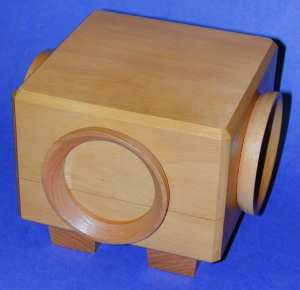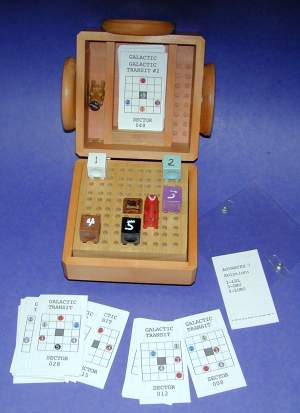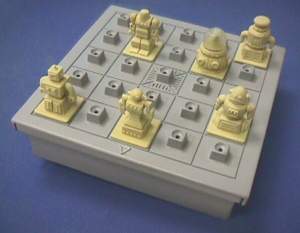


| Designer | : | Hiroshi Yamamoto |
| Craftsman | : | Binary Arts |
| Category | : | Sequential Movement |
|
Lunar Lockout was originally called UFO. The name was changed by Binary Arts for the commercial version to be released in the spring of 2000. UFO was created by Hiroshi Yamamoto and presented by Nob Yoshigahara in February 1998 at the Third Gathering for Gardner in Atlanta, Georgia. The handout had sample problems using a 9x9 board that turned out to be much larger than necessary for reasonably difficult problems. The board was subsequently reduced to 5x5. Papers with forty or more sample problems for the 5x5 board have been circulating in the puzzle collecting community since the presentation.
Lunar Lockout is a very addictive puzzle. At first, it doesn't look too interesting, but once you begin solving problems, it's hard to stop. The concept is also new. Only two games with remotely similar piece movement were found by searching patents, puzzle books and game books. In April 1999 a game by Alex Randolph called Ricochet Robot (Rasende Roboter in Germany) was published by Rio Grande Games under license from Hans im Glück in Germany. Alex is the creator of TwixT and several other games well known in the recreational mathematics community. The other game (also by Alex) was published by Ravensburger in 1992 and called Die Verbotene Stadt (The Forbidden City). The games used the edge of the board as a barrier allowing piece movement to stop there and various walls and obstacles throughout the board that would also stop a piece. The top two photographs show an early prototype made by Wayne Daniel. Note that the production name under consideration at the time was Galactic Transit. As soon as it's available, a photograph of the production version will be added. The bottom photograph shows a pre-production prototype by Binary Arts. For more in-depth information about Lunar Lockout see the article Computer Analysis of the UFO Puzzle by John Rausch. | ||